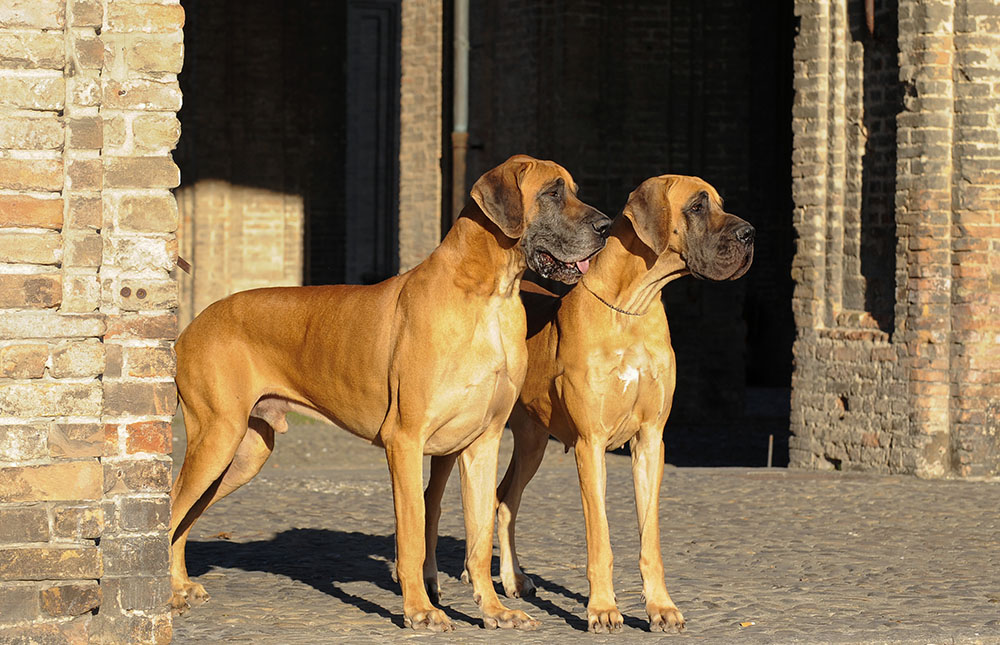Breed Profile – Great Dane
12/05/2017
An impressive working breed, the Great Dane started out life in Germany, not Denmark as the name suggests. Owners need big homes, big gardens and big pockets to take on this giant ‘Scooby Doo’ breed.
History of Breed: Originally a German hunting dog, the Great Dane’s ancestors were of a heavier build than the tall, elegant example we see today. Bred to hunt large prey such as boar and bear, the breed still retains some of its hunting instinct. However, it is now generally content to be a house dog and loving companion. The ears of the Great Dane used to be cropped. This was ostensibly to prevent injury whilst hunting out in the field. The ears would then be made to stand up off the top of the head. Although this practice still occurs in the US, it is now rare in Europe.
Life Expectancy: Under 10 years.
Size: A large dog with a height range of 71-76cm and a weight range of 46-54kg.
Features: A strong, muscular breed with a noble, majestic look and carriage. Their proportions give them a square look whilst remaining elegant. A deep barrel chest leads to muscular shoulders and strong, straight forelegs. The long neck and head are carried high and the eyes are deep set and intelligent. Combined with triangular ears high on the skull and folded forward the Great Dane has an overall alert expression. The coat is short and sleek, coming in a variety of colours including fawn, black, brindle and harlequin. The Great Dane’s tail is long and tapered, carried level with the back and never curling over.
Energy Levels/Exercise Required: Great Danes require plenty of exercise, more than two hours per day. However, once they’ve used up their energy, the breed is content to rest at home. As with all large breeds, they have a period of rapid growth in puppyhood, which puts them at risk of developing bone and joint problems. It is important to limit exercise in young dogs to avoid putting pressure on young joints.
Potential Health Problems: Deep-chested breeds such as the Great Dane can be susceptible to bloat or Gastric Dilatation Volvulus. This potentially fatal condition needs to be treated quickly, so owners should be aware of the early symptoms and seek medical attention as soon as they suspect bloat. Hip dysplasia is an inherited condition that can start earlier if puppies are over-exercised or if dogs carry too much weight. Being careful not to let puppies jump from heights or go up and down stairs is a good precaution. Feeding to condition with a dog food containing a bone and joint complex can also help prevent early onset of this condition. Gilpa Kennel specifically caters to large and giant breeds like the Great Dane. It has a larger biscuit size to suit a larger mouth and contains New Zealand green-lipped mussel extract to promote joint health.
Heart conditions are a common problem with Great Danes, in particular dilated cardiomyopathy. Although some dogs live up to ten years, most live to around six to eight years. Their short life span and tendency to heart problems has led to their nickname of ‘the heartbreak breed’.
Temperament: The breed is affectionate, friendly and loving, a real gentle giant. With thorough early socialisation they show no signs of aggression whatsoever. If socialisation does not take place correctly, they can be wary of strangers and new environments.
Child Friendly/Family Dog: A gentle breed, the Great Dane is great with children and makes a fantastic family dog. They especially love being centre of attention in a family with older children who enjoy plenty of outdoor activity. Furthermore, they are happiest in a large house with room to spread out and a large outdoor space to run off excess energy. Due to their size, supervision is vital with babies, toddlers and young children to avoid accidents involving crushing. They also show no problems being around other dogs and other non-canine pets.
Likes: Affection, cuddles, attention, exercise, space.
Dislikes: Lack of space, lack of attention, being alone.
This breed profile uses information from Wikipedia, The Kennel Club and Dorling Kinderlsey’s ‘The Complete Dog Breed Book’.



